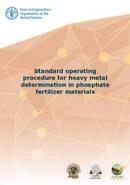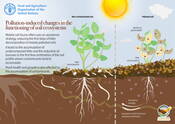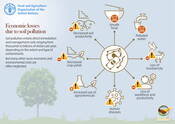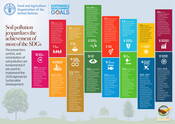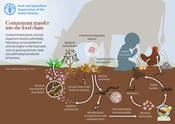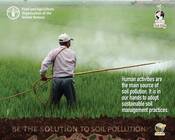
International Network on Soil Pollution
The International Network on Soil Pollution (INSOP) has the overall aim of stopping soil pollution and achieving the global goal of zero pollution. To this end, INSOP works to improve knowledge on the full cycle of soil pollution, from assessment to remediation, as well as on the effect on environmental and human health and the provision of soil ecosystem functions and services. INSOP also aims to strengthen technical capacities and legislative frameworks for the prevention of soil pollution and promotes the exchange of experiences and technologies for the sustainable management and remediation of polluted soils. For more information contact: [email protected] and the: GSP-Secretariat.
How to get involved
INSOP welcomes members from around the world who share the vision of a world with Zero Pollution and healthy soils. INSOP's membership is free of charge and its success is based on the active and voluntary participation of each of its members. Please sign in to join the network.
Join INSOP
INSOP functions and duties
INSOP’s mission is to support and facilitate joint efforts towards reducing the risks of soil pollution and effectively remediate already polluted areas.
INSOP serves the global community by:
• Providing an international forum for the generation and dissemination of knowledge on soil pollution;
• Promoting and exchanging good practices, practical and scientific knowledge and innovative solutions for managing polluted soils in a sustainable manner;
• Establishing interdisciplinary cooperative links between governments, academia, the private sector, and society to stimulate the development of cleaner and more sustainable solutions and consumption options; and
• Strengthening technical and technological capacities through coordination among existing networks.
INSOP is dedicated to enhancing global capacity to prevent and mitigate the effects of soil pollution by developing comprehensive, online training modules to assist stakeholders in tackling soil pollution. The trainings aim to empower individuals tasked with identifying soil pollution, performing risk assessments, implementing successful remediation strategies, and assisting countries affected by mines and explosive remnants of war. By making the trainings widely available, INSOP fosters knowledge-sharing and equips countries with the tools to protect soil health and ensure sustainable environmental management practices. READ MORE
INSOP welcomes representatives from governments, academia, the private sector, NGOs, and any other stakeholders from around the world who share the vision of a world with Zero Pollution and healthy soils. Please complete this form to join the Network Once your registration has been processed, your organization will be included on the INSOP’s interactive map (see below). INSOP's membership is free of charge and its success is based on the active and voluntary participation of each and every one of its members.
Capacity development
As part of the FAO programme “Restoring Livelihoods and Revitalizing Rural Communities Affected by Mines and Explosive Remnants of War,” the Global Soil Partnership (GSP) is equipping academics, governments, NGO’s with the knowledge and tools needed for accurate soil pollution identification, risk mitigation, and the development of contaminant reduction strategies. These efforts aim to support a sustainable and resilient agricultural future for countries affected by mines and explosive remnants of war. In collaboration with the Global Soil Laboratory Network (GLOSOLAN) and the International Network on Soil Pollution (INSOP) experts, the GSP has developed comprehensive theoretical courses to establish a strong foundation in soil pollution assessment protocols.
Read MORE
INSOP Publications
Global Assessment of Soil Pollution
Main report
EN
Soil pollution on the move – How leaching causes groundwater pollution ITPS Soil Letters #10
INSOP Governance
INSOP Chair: Ravi Naidu
INSOP Vice-Chair: Deyi Hou
INSOP coordinator: Natalia Rodriguez Eugenio
Assessment WG: Helen Karasali
Monitoring WG: tbd
Remediation WG: Scott D. Warner and Fang Wang
Food Safety WG: David O'Connor
PRIORITIES OF THE ASSESSMENT WORKING GROUP ON SOIL POLLUTION | OCTOBER 2023 VERSION
|
|
| |
PRIORITY 1 | Advocate for the development of global harmonized methods, including standard operating procedures (SOPs) to identify and measure soil pollutants |
| |
OUTCOME | Soil laboratories are well-informed about the harmonized SOPs for soil pollutants and their usage |
| |
KEY PERFORMANCE INDICATORS | LONG TERM By 2025, 80 percent of soil laboratories working with the GSP will be aware of how to use the harmonized SOPs for measuring soil pollutants in the laboratory | SHORT TO MEDIUM TERM At least one soil laboratory working with the GSP from each region is involved in the development of harmonized SOP | |
KEY ACTIVITIES |
|
| |
PRIORITY 2 | Advocate for creating a global database on soil pollutant threshold values in agricultural soils and other land uses focusing on heavy metals and pesticides |
| |
OUTCOME | (1) Foster a deeper understanding of existing soil pollutant threshold values worldwide; and (2) Countries making informed decisions based on the data and information of soil pollutant threshold values |
| |
KEY PERFORMANCE INDICATORS | LONG TERM Number of countries are working towards the adoption of threshold values for soil contaminants within national regulation | SHORT TO MEDIUM TERM At least 50 percent of the countries are involved in the discussions on the establishment of threshold values for soil pollutants. | |
KEY ACTIVITIES |
|
| |
| WORKING GROUP 2: MAPPINGThe generation of a spatial datasets on the distribution of polluted soils and potential sources of pollution is of utmost importance in informed decision making. This area of work is carried out in close consultation with the International Network of Soil Information Institution (INSII). |
SCOPE | The overall objective of the 'Working Group (WG) 2: Mapping' is the identification of potential sources of pollution. This is of utmost importance in informed decision-making, so that pollution "hot spots" or areas of special concern due to the risk to human health and the environment can be easily identified. The overall goal is the generation of a spatial datasets on the distribution of polluted soils and potential sources of pollution. Collaboration with the INSII and its members will focus on a better understanding of the coexistence of contaminants and facilitate the management of sites with mixed contamination. Read more |
DATE OF THE MEETING | to be confirmed |
ACTIVITIES | Content available soon |
JOIN INSOP NOW |
PRIORITIES OF THE MONITORING WORKING GROUP (WG) ON SOIL POLLUTION | OCTOBER 2023 VERSION
|
|
| |
PRIORITY 1 | Advocate for a better understanding of national legal instruments on the prevention, monitoring and/or remediation of soil pollution |
| |
OUTCOME | A global INSOP database is developed and utilized by the countries to learn about the existing legal instruments of soil pollution prevention, monitoring and/or remediation |
| |
KEY PERFORMANCE INDICATORS | LONG TERM Proposal of an international instrument that positions soil pollution as a major global challenge and monitors its impacts | SHORT TO MEDIUM TERM Number of countries advocating for the development of soil pollution legal instrument | |
KEY ACTIVITIES |
|
| |
| |||
PRIORITIES OF THE REMEDIATION WORKING GROUP ON SOIL POLLUTION | OCTOBER 2023 VERSION
|
| |
PRIORITY 1 | Advocate for the development of national capacities and strengthen technology transfer for remediation and sustainable management of polluted soils | |
OUTCOME | (1) INSOP remediation database is widely recognized; and (2) Sustainable practices are disseminated among countries for remediating polluted soil, maximizing environmental, social, and economic benefits | |
KEY PERFORMANCE INDICATORS | LONG TERM An international database of sustainable soil pollution remediation practices is available for global use | SHORT TO MEDIUM TERM At least 60 percent of countries are represented through case studies in the global database |
KEY ACTIVITIES |
| |
INSOP meetings
INSOP Workshop
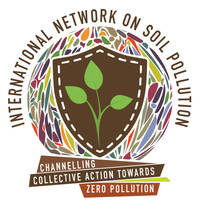
Harmonizing action on pesticide residues in soils through tools, data and capacity building | 26 June | READ MORE
Assessing and mitigating soil pollution in cocoa-growing plantations in Latin America and the Caribbean | 27-28 January 2025 | READ MORE
Soil Pollution Threshold Values | 3 October 2024 | READ MORE
INSOP Sustainable Management Working Group Meeting on remediation of polluted soils
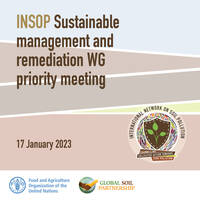
Virtual meeting | 17 january 2024 | READ MORE
INSOP Food Quality working group meeting on farmers' training and soil pollution indicators in the One Health approach

Virtual meeting | 14 December 2023 | READ MORE
INSOP Assessment WG meeting on SOP's for pesticides and soil pollutant threshold values

Virtual meeting | 16 November 2023 | READ MORE
International Network on Soil Pollution (INSOP) annual meetings
INSOP-INFA joint meeting on fertilizer quality assessment
INSOP meeting on national legal instruments for the prevention, monitoring and/or remediation of soil pollution
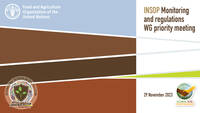
Virtual meeting | November 29 2023 | READ MORE
INSOP News
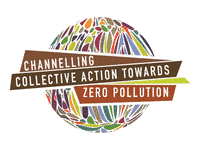
Read the latest INSOP bulletins:
Geographical distribution of INSOP members
Related activities

Global Symposium on Soil Pollution
2-4 May 2018, FAO headquarters
The Symposium was attended by more than 500 participants from 100 countries, including member states, academia, the private sector as well as scientists and land users working on soil pollution and related fields.

Plan of Action - GSOP18
Symposium Outcome document
The recommendations presented in the document support policies and actions that enhance the prevention, minimization and remediation of soil pollution through sustainable soil management.

Open International Forum-Webinar
8 Nov 2022, 13:00-16:00 CET
This webinar, organized on the grounds of the Russian Timiryazev State Agrarian University will open a discussion on environmental regulation of the quality of phosphate fertilizers.

INSOP LAUNCH
TThe International Network on Soil Pollution (INSOP) was launched on 22 April 2022 at a virtual event, as part of FAO’s observance of International Mother Earth Day. Read more on the launch event.
Related publications
Communication material
Soil pollution - Be the solution to soil pollution: Campaign material (World Soil Day 2018 and Global Symposium on Soil Pollution)

Be the solution to soil pollution
Over thousands of years of human activities have left a legacy of polluted soils worldwide.
Other languages: Italian

Soil pollution and phytoremediation
Some plants can uptake, remove and stabilize contaminants from the soil, through different mechanisms.
Impacts of soil pollution on key soil functions
Soil pollution causes a chain of degradation processes in soil, jeopardizing its ability to provide ecosystem services.
Pollution-induced changes in the functioning of soil ecosystems
Mobile soil fauna often uses an avoidance strategy, reducing the first steps of litter decomposition in heavily polluted soils.
Economic losses due to soil pollution
Soil pollution entails direct remediation and management costs ranging from thousands to billions of dollars per year, depending on the extent and type of contaminants.
Soil pollution jeopardizes the achievement of most of the SDGs
The prevention, control, and remediation of soil pollution are fundamental if we want to implement the 2030 Agenda for Sustainable Development.
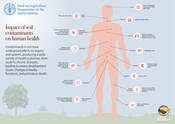
Impact of soil contaminants on human health
Contaminants in soil have widespread effects on organs and systems, producing a wide variety of health outcomes, from acute to chronic diseases, leading to severe development issues, changes in bodily functions, and premature death.
Contaminants tranfer to the food chain
Contaminated plants and soil organisms lead to potentially hazardous accumulations in animals higher in the food web such as grazing animals, birds and ultimately transferred to humans.
Soil pollution, a hidden reality
This poster presents in a nutshell the sources, degradation processes and effects of soil pollution on the environment, human health and food safety and security.
Other languages: Thai
Soil pollution is borderless
Soil pollution is a borderless often invisible threat whose presence and effects are present in every corner of the globe.
Soil pollution postcards
Videos and animations
|
7 things you can do to stop soil pollution Let's be the solution to stop soil pollution! |
|
How can you be the solution to soil pollution? Even through your small actions you can contribute to a big goal, to #StopSoilPollution. Reduce, reuse and recycle can help you, your community by improving your health and the health of our soils. Short version: English |
|
Soil Pollution, a hidden reality Soil is a complex growing habitat that remains productive only when it is cared for and nurtured. Combating and addressing soil pollution means assessing and minimizing the risks for food security, human health and the environment. |








